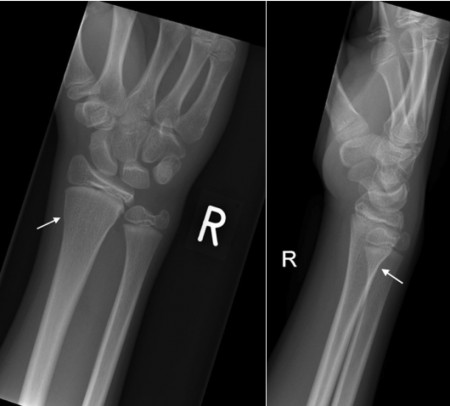

Once the splint is removed the children should avoid contact sports or high energy activities (such as rough and tumble play) for a further 3 weeks to avoid further injury If after 3 weeks the wrist still seems very sore, swollen, or the child is not willing to use it, please contact the ED secretary on 01 where follow up arrangements will be made. If the child remains in significant distress despite the splint and regular analgesia, they should return to ED for review. They will usually be fine to attend school after the first day. The child should receive regular simple analgesia for the first few days following injury. The splint should be worn for 3 weeks, but can be removed for bathing, showering and for sleep. These patients can be discharged with a parent information leaflet and no planned follow up. Splint can be used if there is a buckle seen on both radius and ulna. This has been shown to be at least as effective as a cast in terms of facilitating healing, but can promote earlier functional recovery. A rigid cast is not recommended 4, instead a removable splint should be applied. (demonstrating extension of fracture line to volar cortex with angulation of the volar cortex)īuckle fractures have excellent cosmetic and functional prognosis. Imaging Findings of the Distal Radio-Ulnar Joint in Trauma - Scientific Figure on ResearchGate.Įxample xray of greenstick fracture of distal radius: Buckle fractures of the volar cortex should be in the same way as greenstick fractures, with below elbow backslab and fracture clinic 1 week.Įxample xray of Salter Harris type 2 fracture of distal radius:.Ensure there is no angulation especially of the volar cortex.Ensure the fracture line does not extend to the volar cortex.From the case rID: 10733īe careful not to misdiagnose Salter Harris II or Greenstick fractures as a simple Buckle fracture, as these can be unstable 3 requiring immobilisation with cast, and orthopaedic follow up.

The bulge may be seen at both the ulnar and radial aspects of the bone.Įxample xray of distal radius buckle fracture:Ĭase courtesy of Dr Maulik S Patel,. This is most frequently seen on the dorsal aspect of the distal radius but can appear on distal ulna or both distal ulna and radius. 1īuckle fractures are common injuries sustained by children >2 years old 2, typically following a fall on the outstretched hand.Īs the developing bone is relatively soft, the trabeculae is compressed, resulting in the appearance of a bulge. This article highlights the different types of splints and casts that are used in various circumstances and how each is applied.Incomplete compression fracture at the metaphysis of the distal radius, ulna or both in which one cortex is disrupted, and the other remains intact. Indications and accurate application techniques vary for each type of splint and cast commonly encountered in a primary care setting. Selection of a specific cast or splint varies based on the area of the body being treated, and on the acuity and stability of the injury. All patients who are placed in a splint or cast require careful monitoring to ensure proper recovery. Rigid casts are usually made from plaster of Paris or fibreglass and are customised to fit the individual child.
BUCKLE FRACTURE WRIST TREATMENT FULL
Depending on the type of fracture, treatment ranges from full immobilisation using a rigid cast to simple splinting with a soft or elasticated bandage. Excessive immobilization from continuous use of a cast or splint can lead to chronic pain, joint stiffness, muscle atrophy, or more severe complications (e.g., complex regional pain syndrome). Most wrist fractures in children do not need surgical intervention. To maximize benefits while minimizing complications, the use of casts and splints is generally limited to the short term. Because of this, casts provide superior immobilization but are less forgiving, have higher complication rates, and are generally reserved for complex and/or definitive fracture management.

This quality makes splints ideal for the management of a variety of acute musculoskeletal conditions in which swelling is anticipated, such as acute fractures or sprains, or for initial stabilization of reduced, displaced, or unstable fractures before orthopedic intervention. Splints are noncircumferential immobilizers that accommodate swelling. Management of a wide variety of musculoskeletal conditions requires the use of a cast or splint.


 0 kommentar(er)
0 kommentar(er)
